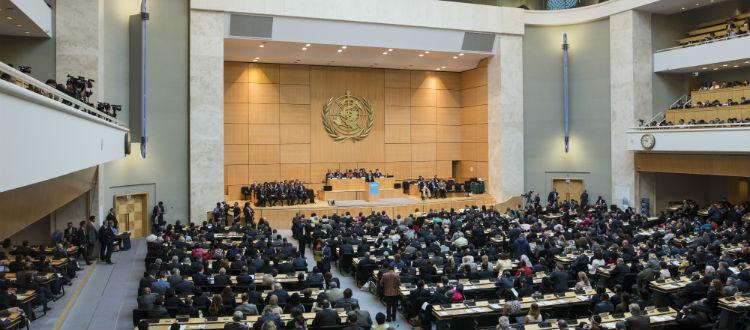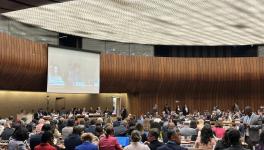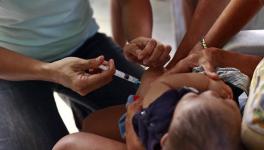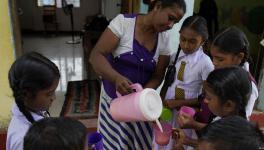WHO’s Reluctance to Implement WHA Resolution Affects Access to Affordable Biotherapeutics

Image Courtesy: WHO
There is reluctance in the WHO Secretariat’s reluctance to implement the World Health Assembly Resolution on “Access to Biotherapeutic Products including Similar Biotherapeutic Products and Ensuring their Quality, Safety and Efficacy” (WHA 67.21). This compromises the availability of affordable non-originator biotherapeutics, also known as ‘biosimilars’ or ‘similar biotherapeutic products’.
Biotherapeutic drugs (commonly referred to as ‘biologics’ or ‘biopharmaceuticals’) are drugs produced through biological processes. These drugs are different since they are produced in living cells. In contrast to chemically synthesised ‘small molecule drugs’, biologics are relatively larger in size, and much more complex and difficult to characterise. Biologics have several potential advantages as they can, theoretically, be tailored to hit specific ‘targets' in the human body. Some well-known biotherapeutic products include human insulin, erythropoietin (EPO) and monoclonal antibodies.
There is a huge market for biotherapeutic products. In 2018, biotherapeutics accounted for 6 of the 10 top selling branded drugs in terms of revenues. The WHO list of essential medicine also includes three of the top-selling biotherapeutics – Trastuzumab, Rituximab and Bevacizumab. The success of biologic drugs reflects their ability to treat chronic diseases, including cancers and autoimmune disorders, much better than existing alternatives and with fewer side effects. Unfortunately, both accessibility and affordability of this new class of medicines in developing countries is abysmally low, largely due to their high prices. Unlike small molecules, where generic uptake is high, the road to uptake of similar biotherapeutic products (SBPs) is paved with many obstacles, including but not limited to technology, intellectual property and regulatory requirements.
Among the aforementioned obstacles for SBPs uptake, regulatory barrier is one of the major impediment affecting their accessibility and affordability. The current regulatory framework for SBP approvals in many countries is in accordance with WHO’s Guidelines on Evaluation of Similar Biotherapeutic Products (SBP Guidelines) which was adopted in 2009. Many WHO Member States including India and South Korea have replaced their existing SBP regulatory guidelines with new guidelines, in consonance with the 2009 Guidelines. Regulatory requirements under the current SBP Guidelines are plagued with many barriers for increasing the availability of affordable SBPs in the market, the prominent being clinical trials, interchangeability and extrapolation of indications.
Also Read: The Road to Access – Discussions on Medicines at 71st World Health Assembly
With regard to clinical trials, the 2009 WHO Guidelines insist on: “Head-to-head comparison of a biotherapeutic product with a licensed originator product with the goal of establishing similarity in quality, safety, and efficacy. Products should be compared in the same study using the same procedures”. Scientists from a range of countries through a Memorandum to WHO have questioned the head-to-head comparison for SBP approval. According to them, these clinical trials are not equipped to detect any meaningful difference in the safety profiles of SBPs.
During the clinical development of SBPs, the interpretation of limited differences in the product profile is extremely difficult and only a very large cohort study may provide some meaningful information. Further, the insistence on clinical trials makes SBP development a highly cost intensive and time-consuming process.
During the authors’ discussion with a company involved in SBP development, it was revealed that the current SBP Guidelines make the development process a highly time-consuming exercise, requiring an investment of approximately 7 years till the commercialisation stage. Furthermore, the comparative clinical trials require 50% of the clinical subjects to be put on originator product. The sourcing of the originator product, which constitutes almost 50% of their developmental cost, at times becomes extremely challenging. The financial implications of clinical trials along with the time requirement is a major deterrent, if not a barrier, for many companies, thus representing an obstacle to SBPs adoption and consequently, reduction of health care costs and accessibility.
Another barrier for the rapid adoption of SBPs, and to reduce cost and increase access of these drugs is the absence of an interchangeability designation. Interchangeability is the inherent property of a product and a condition for substitution that allows substituting an originator biotherapeutic with the SBP, at the pharmacy level, without the consent of the prescribing physician. Although interchangeability and substitution bear a close relationship, yet they have different meanings. To receive the interchangeability designation, the manufacturer must demonstrate not only that the SBP has a similar efficacy and safety as compared to the originator biotherapeutic, but also that there is no greater risk in switching between the SBP and the originator.
To impede the acceptance of SBPs in the market, the originator companies have allegedly linked switching from an originator product to SBP with the increased risk of immunogenicity. Immunogenicity is defined as the ability of a substance to produce an immune response and is one of the key factors for producing a safe biopharmaceutical drug. Immunogenicity of biotherapeutics is a widely studied phenomenon and among some 16,000 published papers, there has been no data associating switching with immunogenicity. No scientific evidence has been established for any possible biological or clinical adverse effect caused by switching a patient from an original product to its SBP. In many European countries, there are rules against substitutions; however, some EU national regulatory authorities (NRAs) have declared SBPs as interchangeable. The WHO Guidelines do not include a statement on interchangeability of SBPs and have left the decision to the respective NRAs. In principle, WHO’s reservation to designate SBPs as interchangeable, has posed a major hindrance to their rapid adoption.
Also Read: Who Benefits from a Compromised World Health Organisation?
In addition to interchangeability, extrapolation across indications represents another major regulatory barrier for SBP adoption. Extrapolation is the approval of a SBP for use in an indication that is held by the originator biotherapeutic but not directly studied in a comparative clinical trial with the SBP. According to the existing regulatory framework, an SBP may be approved for all indications for which the originator product is approved without clinical requirements, provided it demonstrates comparable efficacy with the originator biotherapeutic product. However, such an approval may also be denied based on scientific justifications. On the other hand, certain scientific reasoning have been propounded countering the current regulatory framework on extrapolation of indications.
According to concerned scientists’ memorandum, one of the major characteristics of biotherapeutic drugs is their high degree of specificity. Hence, for a SBP that is comparable in nature, differences in clinical efficacy for different indications would be difficult to contemplate. The purpose of introduction of SBPs was to reduce the cost of biotherapeutic products and to make them more affordable and accessible, which was to be achieved by an abridged procedure for regulatory approval. Such onerous dossier requirement for regulatory submissions entails significant expenditure for the SBP manufacturer. If such rigorous demands for extrapolation persist, the mandate to make lower costs SBPs available to the diseased population can never be realised.
In considering the access challenge emanating from the regulatory pathway, the 67th World Health Assembly adopted Resolution WHA 67.21. In taking cognisance of the repercussions of the regulatory challenges on affordability and better access to treatments of biotherapeutic drugs, Operational Paragraph 1 (3) requested the Member States: “to work to ensure that the introduction of new national regulations, where appropriate, does not constitute a barrier to access to quality, safe, efficacious and affordable biotherapeutic products, including similar biotherapeutic products”.
Most importantly, Operational Paragraph 2 (4) requested the WHO Director-General: "to convene the WHO Expert Committee on Biological Standardization to update the 2009 guidelines, taking into account the technological advances for the characterisation of biotherapeutic products and considering national regulatory needs and capacities and to report on the update to the Executive Board”. Thus, from the above mandate. it can be inferred that the scientific reasons on which the 2009 Guidelines were based are out of sync with the current advancements in science and technology.
However, the WHO, instead of updating the existing Guidelines as mandated by the WHA, has come up with a Question and Answer (Q&A) document providing further clarifications on the 2009 SBP Guidelines. The Secretariat provided the following justification for the same: "In April 2015, an informal consultation was organised during which participants from NRAs of both developing and developed countries, as well as from industry, recognised and agreed that the evaluation principles described in the Guidelines were still valid, valuable and applicable in facilitating the harmonization of SBP regulatory requirements globally. It was therefore concluded that there was no need to revise the main body of the existing Guidelines.”
Also Read: AC/VC: The Shock of WHO Funding
This justification itself raises certain legitimate questions. First, the WHA 67.21 gave a clear mandate to the WHO Director-General “to convene the WHO Expert Committee on Biological Standardization to update the 2009 Guidelines”. Thus, the WHA resolution clearly tasked the WHO Secretariat to update the SBP Guidelines, and not to have consultations to discuss and take a decision on whether to update the Guidelines or not. What remains unanswered is whether the mandate of the WHA can be overruled by such informal consultations convened by the Secretariat. Legally speaking, the WHO Secretariat cannot overrule the decision of its highest decision-making body.
Second, the Secretariat’s explanation is that the decision on non-revision was taken in consultations with the NRAs and the industry. Thus, the Secretariat assumed that the NRAs are a separate entity above the Member States and the WHA resolution may be adopted in consultations with the NRAs. Interestingly, the 2015 informal meeting was represented by the industry as well. Furthermore, the manner in which the consultations were done casts doubts on the entire update process. The Q&A goes to state that: “WHO convened a series of meetings to identify those parts of the Guidelines which required updating”. There is complete paucity of public information on these series of meetings and the issues discussed. Interestingly, the WHO Secretariat has not released any details of the meetings, especially the 2015 informal meeting mentioned in the Q&A including verbatim records, list of participants or the agenda of the informal meetings.
Third, the decision of the WHO to not update the SBP Guidelines was based not on any scientific reason but on global harmonidation of the regulatory requirements. It states: "NRAs of both developing and developed countries, as well as from industry, recognided and agreed that the evaluation principles described in the Guidelines were still valid, valuable and applicable in facilitating the harmonidation of SBP regulatory requirements globally.” Harmonisation has historically aimed at setting uniform standards globally, often favouring the big companies to pursue their commercial interests and is oblivious to the needs of the developing countries. Consequently, it prunes the ability of developing member countries to address their public health concerns. On the current issue at hand, it has also faltered to underpin the needs of the developing nations with respect to affordability and accessibility of SBPs.
In 2017, the WHO Secretariat convened an “Expert Consultation on Improving Access to and Use of Similar Biotherapeutic Products” with following purpose: "WHO's support to the Member States in regard to SBPs has thus far concentrated on the development and implementation of regulatory guidelines, reference preparations, and nomenclature standards. Going forward, additional types of support will be needed which may include (but not be limited to) the development and dissemination of policy guidance and treatment guidelines. The purpose of the consultation was to canvas the opinion of experts to advise WHO on activities that might be prioritided to facilitate improved access to and use of SBPs”.
The focus of this meeting was mainly on the post-marketing approvals. One of the outcomes of the meeting stated in the report was: "WHO will review and provide clarification on the SBP 2009 guidelines to reflect technological and analytical advances". However, the Q&A has completely overlooked the technological or analytical advancement in the field of SBP development and has consequently failed to address relevant concerns regarding clinical trials, interchangeability and extrapolation of indications, which have a major impact on accessibility and affordability.
Also Read: World Health Assembly: Several Countries Pledge to Improve Access to Assistive Technologies
It can thus be inferred that the WHO meetings to update the SBP Guidelines clearly lacked a focussed discussion on the revision based on technological advancement of characterisation of SBPs. The annexed agenda to the report neglects the analytical characterisation studies in the pre-clinical stages, which could have played a pivotal role in addressing the affordability concerns. Scientists from across the globe have submitted a memorandum questioning the Q&A update. The document states the following: “serious concern remains among the scientific community that presenting guidelines as a Q&A document alone does not serve the intended purpose. A revision of the current guidelines is still needed, as mandated by the WHA 67.21, to expand availability of safe and effective biosimilars”.
The memorandum recommends updating the Guidelines based on certain scientific principles and to help national authorities better implement policies to make SBPs less costly. Some of the pertinent points, apart from the ones already incorporated in the aforementioned regulatory barriers discussion, include the following:
- A demonstration by an SBP exhibiting comprehensive characterisation and analytical comparison at the quality level should be sufficient to ensure the safety and efficacy of the products;
- Emphasis on quality testing should be focused on impurity profiles and potency;
- Well-defined pharmaco kinetics and pharmacy dynamics studies should be sufficient (in case clinical studies are deemed necessary); immunogenicity studies should only be conducted where SBP does not match the critical quality attributes related to manufacturing and default interchangeability and extrapolation to all indications unless there are scientific reasons to deny the same.
These suggestions would drastically drop the financial cost as well as the duration for commercialisation of biosimilars.
The failure of the Expert Committee on Biological Standardisation and the WHO Secretariat to update the SBP Guidelines to reflect the current scientific evidence and technological advancements, compromises access to affordable biotherapeutic products, as the unnecessary requirements of the SBP Guidelines hinder the prompt availability and accessibility of affordable SBPs. This has grave consequences for the realisation of the right to health and the right to enjoy scientific progress and its applications (right to science).
Another important attempt by WHO to reinforce the current regulatory paradigm is through the pre-qualification (PQ) of SBPs. As of September 2017, 30 national regulatory agencies have agreed to accept the SBPs PQ. As a result, WHO pre-qualified products would automatically gain marketing approval by the 30 participatory NRAs. PQ is most often used to facilitate internationally funded procurement programs such as those of Unitaid, UNICEF (United Nations Children’s Fund), GAVI (Global Alliance for Vaccines and Immunisation) and the Global Fund.
However, in the case of biotherapeutics, PQ is aimed at not only facilitating the international donor sponsored tenders but also facilitating faster regulatory approvals and harmonisation of regulatory practices among Member States. The WHO’s plan to advance with PQ in biotherapeutic products, based on its current SBP guidelines will ultimately benefit the big companies to obtain easy registrations thereby reinforcing a system which imposes strenuous conditions on SBP manufacturers.
It seems that WHO’s actions since the adoption of WHA 67.21 are not to implement the resolution in its letter and spirit but to further impede the availability of affordable SBPs in the market through regulatory barriers. The key question that remains is whether the WHO Member States will take up this issue in the upcoming 72nd WHA, which is to take place from May 20-28, 2019, in Geneva.
Get the latest reports & analysis with people's perspective on Protests, movements & deep analytical videos, discussions of the current affairs in your Telegram app. Subscribe to NewsClick's Telegram channel & get Real-Time updates on stories, as they get published on our website.
























